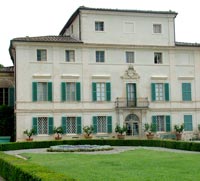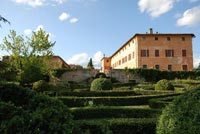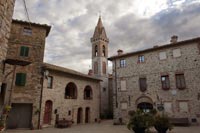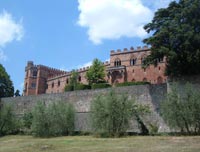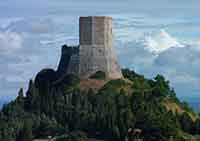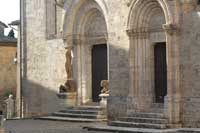Castelnuovo Berardenga
|
Castelnuovo Berardenga is located about 50 km southeast of Florence and about 14 km east of Siena, not far from the evocative Crete Senesi. It has an interesting old clock tower and a relaxing ambience. However, the main reasons to visit Castelnuovo Berardenga lie more in the surrounding area, particularly the Certosa of Pontignano, the italianate gardens of Villa Chigi Saracini and Villa di Geggiano, the English garden of Villa di Monaciano, and villages such as San Gusmè. |
Montaperti is in the municipality of Castelnuovo, and was the theatre of the battle of 4 September 1260 between Guelphs and Ghibellines. |
Founded in the 9th century, Castelnuovo Berardenga has a fine old town centre with a 14th century tower known as the Torre dell’Orologio, the Church of St Giusto and St Clemente and the Museo del Paesaggio. Main sights are he remains of the castle, built by the Sienese in 1366, the Prepositura church, with a Madonna with Child by Giovanni di Paolo, Villa Arceno, Villa di Catignano and Villa di Geggiano, in Pianella. |
||
Torre Civica o dell'orologio |
||
Chiesa dei SS. Giusto e Clemente The Parish church of Saints Giusto e Clemente preserves a beautiful painting by Giovanni di Paolo (1426), the Madonna with child and the angels. The construction of the actual church is due to the initiative of the Count Alessandro Saracini. His family owned up to the end of 1700 the church Saint Giusto, situated outside of the habitat, and the oratory of Saint Clemente, situated inside the medieval nucleus of Castelnuovo Berardenga. The same family Saracini demolished the first after their blessing was removed on the 30 June 1779, the other was also demolished to then be rebuilt as a noble chapel in the complex of the villa Chigi Saracini. The Saracini family committed, along with the community of Castelnuovo, to build at their own expense a new church dedicated to the Saints Giusto and Clemente. The construction, undertaken in 1843 under the supervision of Agostino Fantastici, was fi nished in 1846. The family maintained the ownership of the new church and had exclusive use of the chapel. Placed near to the entrance, was the altar entitled the Madonna of the Rosary, to which was transferred a tablet, the central part of a triptych by Giovanni di Paolo (1426) representing the Madonna of the Rosary, already in the oratory of Saint Clemente. The church housed some other paintings one of which being a canvas representing a Deposition by Alessandro Casolari and a Sacra Famiglia (Sacred Family) by Francesco Nasini painted on one of the four confessionals inserted in the niches in brickwork. |
||
| In the centre of Castelnuovo Berardenga one can find the Villa Chigi Saracini. Its vast park is a splendid example of a romantic garden where sculptures, pavilions and fountains fit into a wisely planned natural backdrop. Count Galgano Saracini ordered the construction of the villa and park, which can be set between 1820 circa and 1840, and is in part attributed to architect Agostino Fantastici. The present look of the park is due to the efforts of count Guido Chigi Saracini, founder of the Accademia Musicale Chigiana of Siena. The relationship between Chianti territory and contemporary art dates to 1959 when count Guido Chigi Saracini, founder of the Accademia Chigiana, commissioned sculptures from Vico Consorti for the grounds of the Castelnuovo Berardenga villa. He commissioned sculptor Vico Consorti (1902-1979) from Siena to create a series of statues dedicated to great musicians. Gardens in Tuscany | Villa Chigi Saracini Address: Castelnuovo Berardenga, Via delle Crete Senesi Opening time: on Sundays from 8.00 until 17.00. |
||
| The Parish church of Pacina with its round bell tower can be found just a few kilometres outside Castelnuovo Berardenga on the road that leads to Pianella. The Romanesque Pieve di Santa Maria a Pacina is probably the same church that was dedicated to Santa Maria and mentioned for the first time in a document of 650 regarding the dispute over the possession of some parishes between the bishoprics of Sienna and Arezzo. This dispute lasted for centuries. Until 1267, the Pieve a Pacina belonged to the monks of San Salvatore della Berardenga, who had received it as a donation from the descendents of the Counts Winigi. By the end of the same century the church was at the head of a large parish that numbered as many as sixteen secondary churches. Churches in Tuscany | Pieve di Santa Maria a Pacina |
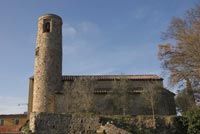 Pieve di Santa Maria a Pacina |
|
The battle at Montaperti |
||
Dante studied under Florence's Chancellor Brunetto Latini, who was himself away from the battle scene, on embassy in Castile seeking help for Guelph Florence from Alfonso X el Sabio. Dante would have learned of the battle, its preparations (documented by Latini in the Libro di Montaperti), strategies and treachery, as well as those of the Battles of Benevento and Tagliacozzo, from the Chancellor,[12] using material also to be gleaned later by Giovanni Villani, the Florentine merchant and historian. As a result Dante reserved a place in the ninth circle of Hell for the traitor Bocca degli Abati in his Divine Comedy:
The Ghibelline commander Farinata degli Uberti is also consigned to Dante's hell, not for his conduct in the battle, but for his alleged heretical adherence to the philosophy of Epicurus.
|
||
 |
||
The battle at Montaperti, Giovanni Villani's Nuova Cronica
|
||
 |
||
Villa Avanzati (San Giovanni a Cerreto, Castelnuovo Berardenga)
|
||
| The Municipality of Castelnuovo Berardenga owes its immense heritage to the typical landscape of its parks and gardens. The Villa di Monaciano has a very innovative style which recalls the Florentine architectural tastes of its time. Within the complex, visitors will particularly appreciate the building’s unique structure and its lovely park which hosts lovely fountains and nymphaeum. The Villa Bianchi Bandinelli is considered a national monument and its structure has immense value both historically and from a naturalistic point of view. This villa is truly a rare gem thanks to its eighteenth century furnishings and decorations which allow visitors to immense themselves in a special atmosphere that recalls by-gone centuries. Visitors won’t want to miss a visit to the Fattoria Miscianello for a taste of Tuscany’s finest wines. |
||
Five kilometres from Siena near Castelnuovo Berardenga, on the top of a hill covered in vineyards, stands the Villa di Geggiano. Owned by the Bianchi Bandinelli family from the first half of the 16 C, was originally a much smaller lodge, which in 1768, was transformed into a grand villa with a garden and its own chapel on the occasion of the wedding of Anton Domenico Bianchi Bandinelli and Cecilia Chigi. Renovated between 1780 and 1790, it forms, together with the surrounding garden, a very unusual complex, both from the historical and the landscaping point of view. A long tree-lined avenue, with cypresses in the first part and holm oaks further on, leads all the way to the entrance gate, parallel to the Teatro di Verzura, the outdoor theatre on the south side of the garden. Villa Geggiano, which dates back to the 13th century, houses a hall frescoed in 1790 by Ignazio Moder, a travelling Tyrolean painter. |
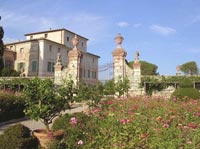 |
|
Musica Reale is a recently started initiative to bring together members of the Royal Concertgebouw Orchestra, in a variety of formations, for the performance of chamber music in all its aspects. All instruments being available in the orchestra, the choice of programming is enormous. |
||
The 700 years old Villa di Geggiano is located in Chianti in Tuscany. The villa and its gardens are a National Heritage property and the organic vineyards produce 50,000 bottles a year of Chianti Classico and Tuscan IGT wines. Among the most famous usage of the Villa di Geggiano was for the film “Stealing Beauty” by Bernardo Bertolucci, in which Liv Tyler debuted. Castle of Montalto |
|
|
Villa di Monaciano, built from 1870 and 1885, by the noble Alessandro Pucci Sansedoni, coming from Siena but living in Florence. Following the spirit of renewal that reigned in Florence during that age, he built a completely innovating complex with villa and garden: moving the entrance road, pulling down the old walls that surrounded the garden and creating a lovely romantic park, in the wake of the parks designed by architects like Poggi in Florence. In terms of the architectural culture it expresses, the villa seems quite far removed from the Siennese tradition, having more in common with Florentine architecture of the second half of the 19 C. The building has three floors and the façade is divided into three parts by pilasters. Gardens in Tuscany | Villa di Monaciano |
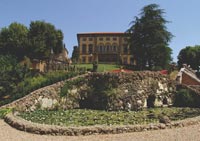 Villa di Monaciano |
|
| Certosa di Pontignano |
||
Founded in 1343 and reconstructed in the second half of ‘500, already property of the Camaldolites, with its church, its priest’s house and its three cloisters it became one of the most beautiful carthusian monasteries in the territory. In the fourteenth century, the Carthusian Order was expanding throughout Italy, and Tuscany was one of their favorite locations. Several monasteries were set up: first among these, the monastery at Maggiano. Later on, two Carthusian monasteries or Certose were built, one at Belriguardo, and one at Pontignano. The church preserves certain 14 C features, such as the thick surrounding walls and the arcades. The chapel, later painted with frescoes by Nasini, was built to host it. The monastery has three cloister gardens. Two are traditional grass rectangles and one is now a renaissance parterre garden. The former monastery of Pontignano has three cloister gardens. In 1959, Certosa di Pontignano was purchased by the University of Siena, who then turned it into a university residence. |
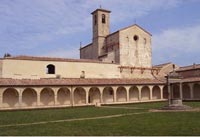 Certosa di Pontignano |
|
|
||
| Castello di Spaltenna is located in Gaiole in Chianti, in the heart of the Chianti Classico wine region. This church alike the similar churches of San Giusto in Salcio, San Polo in Rosso, San Marcellino and San Vincenti, represents a rural settling dating back to the Romans. All those parish churches shared the same plan with three naves divided by quadrangular cross-section pillars and ending with a semi-circular apse.As you enter into the courtyard of Castello di Spaltenna you pass the entrance of Pieve di Spaltenna (Santa Maria di Spaltenna), a small Romanesque church dating back to the first half of the 12th century. Spaltenna was once a medieval monastery connected to the Pieve. The restaurant Il Pievano, run by Davide Canella, is situated at Castello di Spaltenna. The restaurant is open every night and consists of two indoor halls - Sala dei Papi and Sala degli Arazzi- and of the cloister near the parish Church. |
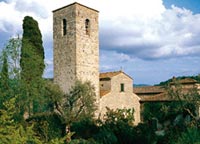 La Pieve di Santa Maria a Spaltenna |
|
| Monastero d'Ombrone is an ancient medieval stronghold, dating from the 11th century. The place name Monasterio refers to the nearby church of San Salvatore della Berardenga. Monastero dell’Ombrone was once the home of the noble Chigi Saracini family of Siena. The Monastery of Ombrone was built to remind the 15th February 867 deed, when Count Winigis and his wife Richilda founded the women monastery of Santi Salvatore e Alessandro di Fontebuona a Campi. Later named San Salvatore della Berardenga. The monastery probably declined and was re-founded in 1003. This time it was given to a Benedictine male community. For the first time in 1028, it is mentioned as part of Camaldoli congregation. In XIV century the Abbey started to decline. Since early 1800 it is not a monastery anymore. Monastery and connected outhouses are currently used as villa and farmhouse. At the North-Western corner of the complex there is a cylindrical tower, re-built over the original one in Neo-gothic style. On the villa Eastern side there is a wooden bridge that leads to the garden. On the villa left side stands a Romanic imposing bell tower in Lombard style with a squared plan. At the opposite side there is the S. Salvatore Church, which is mentioned since monastery foundation. Gardens in Tuscany | Badia Monastero |
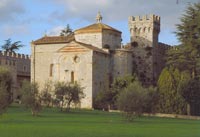 Abbazia d'Ombrone |
|
Montegiachi is located on an embankment over the top of the hill, that dominates the surrounding valley. It was built here on behalf of Antonio Maria of Checco Cinughi, ances one of the Cinghi Counts' several properties in Castelnuovo territory. It has certainly been built before 1522, when Antonio Maria, in his will, left the Villa to his sons Valerio and Alessandro. In 1827, after a careful survey on the villa and outhouses, some parts of the building have been restored. |
||
| The Villa di Catignano was built at the end of the 17th century by Quinto Settano, pseudonym of Monsignor Lodovico Sergardi, a writer and a lover of the arts. The small borough already existed in 1500 with the name of "Clatinianum as a property of Sergardi family. Nowadays the Villa, overlooking a beautiful italian garden, decorated with statues representing the four season, and the medievaltowers of Siena in the distance, is divided into apartments. Gardens in Tuscany | Villa di Catignano Fattoria di Catignano | Località Catignano - 53010 Pianella, Siena |
||
| Vagliagli |
||
Vagliagli, very beautiful borgo in a panoramic position, is situated along the provincial road that leads to Radda in Chianti. The name Vagliagli means Valley of Garlics. The wild garlic appears indeed even into the town's coat of arms: a hand holding a bunch of garlic. The first citation about the splendid village of Vagliagli, ancient hamlet of the XIII century, dates back to 1226 and tells of the Romanesque Church of St Cristoforo, of which you can still find some traces into classic lines of the current bell-tower. Beside the church you can make out in the distance the ruins of a building made in "filaretto di alberese", a special type of grey and and yellow clayey limestone, with traces of the ancient ogive arch portal. Inside the Church of St Cristoforo, on the left, there's a fresco painted by the Sienese School dating to the XVI century, representing St Cristoforo, St Bernardino and St Sebastiano. |
||
Pievasciata |
||
Il Parco Sculture del Chianti Over the years public and private initiatives have been developed on this fertile cultural soil, involving various bodies in experimentation with new itineraries for a cultural crossing of the territory. The Chianti Sculpture Park, which began with the dream of its director Piero Giadrossi, consists of twenty-three works set in 13 hectares of wood in front of the old brick works in Pievasciata. The small hamlet of Pievasciata, with its church of San Giovanni Battista, dating back to the XI century, is just one kilometer away.
|
||
| San Gusmè |
||
| The village of San Gusmè
represents still to this day an example of a fortified village, of large circular form, delimited by an external wall still partly existing. They have conserved the two gateways, even though slightly reshaped, which gave access to the castle. The Siena (Senese) gateway is surmounted by a rectangular plaque in marble with the shield of Siena between two leaves. In 1939 a third gateway was discovered, Porta Nuova (new gateway), which opens at the side of the churches of Saints Cosma and Damiano. The churches of the Saints Cosma and Damiano and of the SS. Annunziata are situated inside the village. A few kilometers from San Gusmè are the notable archaeological sites of Campi and Cetamura. Also near San Gusmè is the medieval hamlet of Villa a Sesta, so far untouched by tourism. Villa a Sesta is a typical and picturesque Chianti village with a prevalent rural economy, located on the route to Brolio. Until the middle of IX century it was a Berardenga Counts possession. A little lower down, a few ruins mark the Castle of Sesta, nicknamed Sestaccia. The fortress, surrounded by an oval ring of city walls, has survived in reasonably good condition, but the remains of the walls consist of just a few stones protruding from the ground. Small villages in Tuyscany | San Gusmè |
||
The Castello di Brolio rises in the centre of the Sienese Chianti area, at approximately half way between Castelnuovo Berardenga and Gaiole in Chianti. Brolio castle is strongly connected to the Ricasoli Firidolfi family, who were invested as lords of Brolio by Frederick Barbarossa in 1167. Today Brolio resembles no longer a manor house, but a Neo Gothic Villa, as a result of works carried out in 1861 for Baron Bettino Ricasoli. Although the castle is private, it is open for visits. And it is still possible to complete the walk of the ramparts, from which we can have splendid sights on the Chianti region. |
||
| Bucine | Rapale and Castello di Rapale |
||
Rapale is a small village on the top of a hill (484 m) with a beautiful overview on the hills of the Chianti area, the Valdambra and the mountains of the Pratomagno. Trekking in Toscana | Castelnuovo Berardenga, tra il Chianti e le Crete Senesi | Anello delle Biancane di Leonina
|
||
| View Larger Map |
||||||||||||||||||||||||||||
The territory of Castelnuovo Berardenga borders the following municipalities: Asciano, Bucine, Castellina in Chianti, Gaiole in Chianti, Monteriggioni, Radda in Chianti, Rapolano Terme, Siena.
The municipality of Bucine contains the frazioni Pogi, Ambra, Badia agnano, Badia a ruoti, Capannole, Cennina, Levane, Mercatale valdarno, Montebenichi, Pietraviva, and San Pancrazio. Bucine borders the following municipalities: Castelnuovo Berardenga, Civitella in Val di Chiana, Gaiole in Chianti, Monte San Savino, Montevarchi, Pergine Valdarno, Rapolano Terme. |
||||||||||||||||||||||||||||
Contemporary art
The relationship between Chianti territory and contemporary art dates to 1959 when count Guido Chigi Saracini, founder of the Accademia Chigiana, commissioned sculptures from Vico Consorti for the grounds of the Castelnuovo Berardenga villa. In the grounds designed by Agostino Fantastici in the first half of the 19th century the count wanted to create an autobiographical narrative that reflected his relationship with music, from Chopin to Boito . Over the years public and private initiatives have been developed on this fertile cultural soil, involving various bodies in experimentation with new itineraries for a cultural crossing of the territory. The most ambitious project, also because it unites Chianti’s two geographical areas (Florentine and Sienese), is the biennial contemporary art event Tusciaelecta. It involves several municipalities and “operates on a possible model of redefinition of the landscape and urban fabric through the insertion of contemporary works on the territory”. The artists, selected by a curator, are invited to explore the territory and design site-specific interventions, taking account of the inputs furnished by the context and of the methods of fruition on the part of a heterogeneous public consisting of residents, tourists and employees. Side by side with the public administrations of this land already rich in monuments from the past, private concerns also enthusiastically offer valid opportunities to discover contemporary art through aesthetic fruition of works and spaces. The Chianti Sculpture Park, which began with the dream of its director Piero Giadrossi, consists of twenty-three works set in 13 hectares of wood in front of the old brick works in Pievasciata. The owners of Castello di Ama carry out actions of pure patronage: since 2000, under the artistic direction of the Galleria Continua of San Gimignano an important artist of international fame has been invited Pistoletto, Buren and Paolini to create permanent works in direct contact with winegrowing culture, thus enriching the estate’s already considerable historical-artistic heritage. |
||||||||||||||||||||||||||||
This itinerary leads us through the great diversity of Terre di Siena, from the red soil of the Montagnola to the clay hills of the Crete stretching from Poggio ai Frati to Mociano and onward to the volcanic plateau from Monteliscai to Valiano. The skyline of Siena is always in sight, dominated by the Torre del Mangia and dome of the cathedral, as we discover the primary characteristics of Siena's magnificent landscape. |
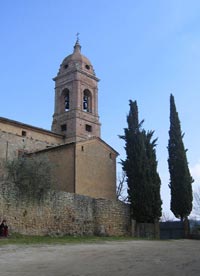 Eremo di Lecceto |
|||||||||||||||||||||||||||
Eremo di Lecceto - Fattoria di Mociano | 25 km, 5 hours |
||||||||||||||||||||||||||||
Our tour begins near the Eremo di Lecceto (12th century) which still hosts a convent of enclosed Agostinian nuns. It's worth a stop, given that the courtyard and church are open to the public. The first part of the itinerary consists mostly of stone trails travelled since 1100 and leads to Castello del Palazzaccio near the Medieval village of Toiano. While crossing the tiny town, the 18th-century villa overlooking it is readily visible. Once outside the village, we ride on level terrain and cross the Fosso dell'Arnano, a hydraulic device commissioned by the Tuscan Grand Duke Pietro Leopoldo I to facilitate the drainage of the swampy Pian del Lago. By way of Carpineto we arrive in Fogliano, home to a 14th-century Romanesque church. At this point we enter the southern part of the itinerary, which explores the magnificent hill country of the Crete and encounters the castle of Poggio ai Frati (12th century), undoubtedly one of the most enchanting moments of the ride. We then cross the towns of Isola d'Arbia and Taverne d'Arbia, finally reaching the Fattoria di Mociano. |
||||||||||||||||||||||||||||
Fattoria di Mociano - Eremo di Lecceto | 35 km, 6 hours |
||||||||||||||||||||||||||||
We are at the easternmost point of our tour, and head north toward the Fattoria di Monaciano, a historical estate dating back to Medieval times. We have passed from the clay of the Crete to the volcanic tufo soil typical of the Chianti, where the landscape is made up of hills, country roads, woodland and vineyards. Having crossed the Chiantigiana road, we encounter Valiano, just by the stable of Luigi Bruschelli, better known as Trecciolino, one of the most successful jockeys in the Palio, the traditional race run twice yearly in Piazza del Campo. By crossing through vineyards we climb toward Vignaglia and reach the area of Pian del Lago, where the gentle hills of the Montagnola Senese begin. From here we proceed toward the 14th-century Eremo di San Leonardo al Lago, protected by a thick cover of Mediterranean brushland featuring oaks and live oaks. Here the final stretch leads back to the Eremo di Lecceto, thus completing the tour. |
||||||||||||||||||||||||||||
The hermitage of Lecceto |
||||||||||||||||||||||||||||
The hermitage is situated a few kilometers from Siena and has been inhabited by Augustinian fathers since the first half of the 13th century to the end of the 1800s, the time of the Napoleonic suppression. In 1972 a female community of Augustinian nuns transferred there from the city of Siena – they were reduced to a few, frail old nuns and their convent was by then falling to pieces and was no longer inhabitable |
||||||||||||||||||||||||||||
A hike to the source of the Ombrone river, near Castelnuovo Berardenga |
||||||||||||||||||||||||||||
Length of journey: 4.5 km
Time: 3.5 hours round-trip Departure point: San Gusmè (Castelnuovo Berardenga - SI) Complete description
|
||||||||||||||||||||||||||||
Maps |
||||||||||||||||||||||||||||
This page uses material from the Wikipedia articles Battle of Montaperti and Nuova Cronica published under the GNU Free Documentation License.
|
||||||||||||||||||||||||||||
|
||||||||||||||||||||||||||||
Hidden away from mass-tourism, discover a piece of Italy which remains largely unchanged both nature and lifestyle-wise. The peacefulness of the countryside, the various unique villages and the friendly atmosphere will no doubt pleasantly surprise you. Holiday accomodation in Tuscany | Podere Santa Pia |
||||||||||||||||||||||||||||
|
||||||||||||||||||||||||||||



